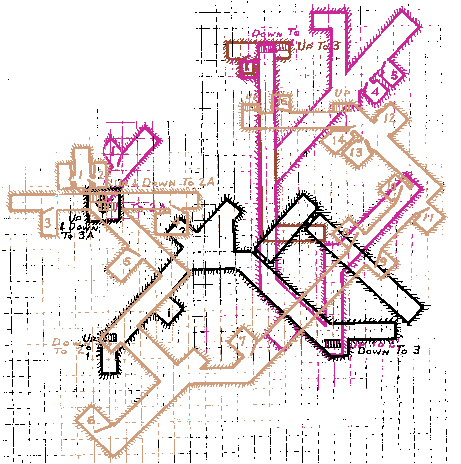
I was bored one day and decided to expand and clarify Dave Arneson's brief notes on Glendower Dungeon.
Glendower Dungeon is almost as old as Blackmoor, and so inherits the pre-D&D "Chainmail" rules. Every monster was assigned a "point" value. This value, in D&D terms, roughly corresponds to the experience points earned when you slay the beast. In Blackmoor Dungeon levels 7 and 8, the point system was adhered to very consistently. In Loch Gloomen's many ruins, dens, and dungeons, this system was used only in approximation.
| Points | Creature | JG Page |
|---|---|---|
| 1.5 | Ghoul | 33 |
| 2 | Dwarf | 33 |
| 5 | Goblin | 33, 60 |
| 15 | Standard Troll, Ogre | 33, 59 |
| 20 | Lycanthrope, Werewolf | 33, 60 |
| 70? | Giant | 60 |
| 75 | True Troll | 33, 59, 60 |
| 75 | Balrog | 33, 60? |
| 85? | Basilisk | 60 |
| 100? | Elemental | 33, 60 |
| 15-40? | "Wright" | 60 |
Note that Arneson confused Wights and Wraiths in those 1972-4 days (also on the Encounter Matrix, p. 23). This could be the source of the wide variation of the "wright"'s point value. My guess is that the Wight has 25 points and the Wraith, 40.
In Chainmail, a single goblin was superior to three ghouls or two dwarves. I'd say that they had a different "ghoul" in mind, and that "goblin" should read "hobgoblin". Also, the Chainmail tanar'ri ("Balrog") were only as powerful as trolls. (BTW: the term "Balrog" appears for reference purposes only; it is the property of JRR Tolkien's estate and is NOT endorsed for use in WotC products.)
It is rumoured that a system of caves connect Blackmoor Dungeon to Vestfold and Glendower. Another aspect the three cities share is that they all contain dungeons. The Great Svenny built Vestfold Dungeon himself (JG p. 53). It is very probable that these dungeons link to the connecting passages. The Fetch is concentrating on the Blackmoor-Vestfold route for now, but he cannot afford to neglect Glendower forever.
The layout of Glendower dungeon is known, but not its location. The Barony of Glendower has a few possible sites:
Oddly, a plan of the dungeon has resurfaced. It became public knowledge in 1005, but it likely dates from 996-1000.
The entire dungeon was artificially constructed. It appears to be unfinished, for many passages lead into dead ends. The rooms are almost uniformly 10' square. Most have doors opening inwards, so it is not a prison (although it may have been designed that way).

The creatures and treasures seem haphazardly placed, consistent with survival patterns after the arrival of a great foe. Apparently some adventurers had visited, cleaned most of it out, and mapped it in anticipation of a return visit. The identity of these adventurers is unknown, but most suspect Svenny, Mello, Willem, and/or Marfeldt. If so, they did not return to the dungeon. The monsters, treasures, and even layout are certain to be obsolete.
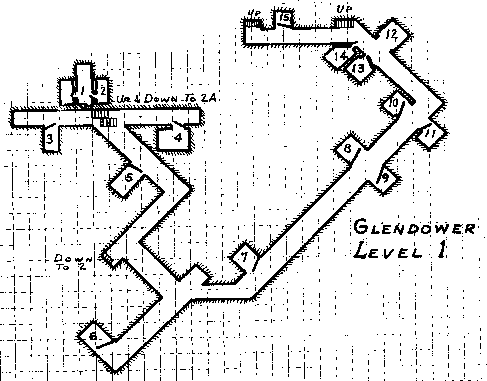
Rooms #8, #9, #10, and #11 face each other along a long, 10' wide corridor. Between them they share 8400 gp and 260 points. The stronger (or more numerous) monsters in #10 will be on the lookout for visitors from the stairs. They might even spring an ambush at a party between these sets of doors.
A very narrow squeeze leads into #14, which contains 1800 gp.
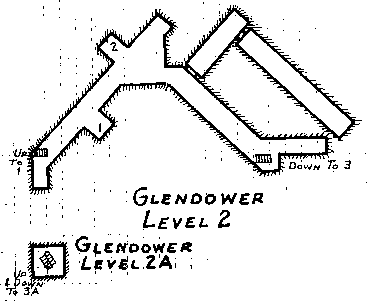
#1 and #2 are alcoves more than rooms. They guard the largest open area in the dungeon. 40 points guard 1000 gp and a dragon egg in #1, and 10 points cower in #2.
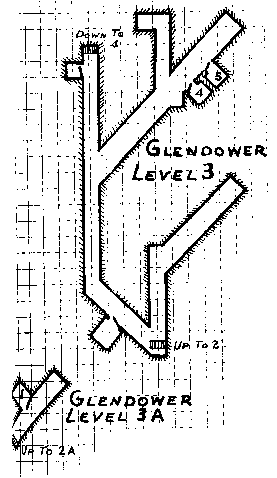
Room #3 isn't labelled, but I'd say it was the room facing the stair to Level Four. 130 points guard the stairs and 5000 gp.
120 points live off to the side, in room #4.
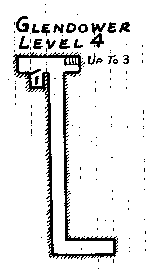
This level, the last recorded, was reputed to be empty.